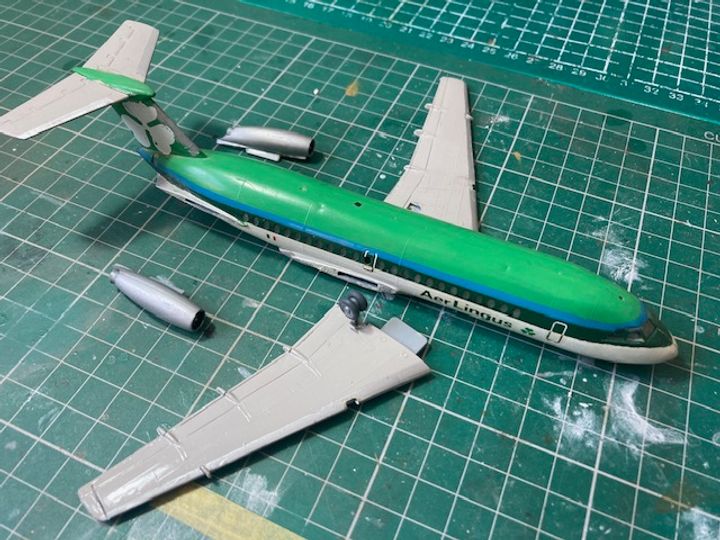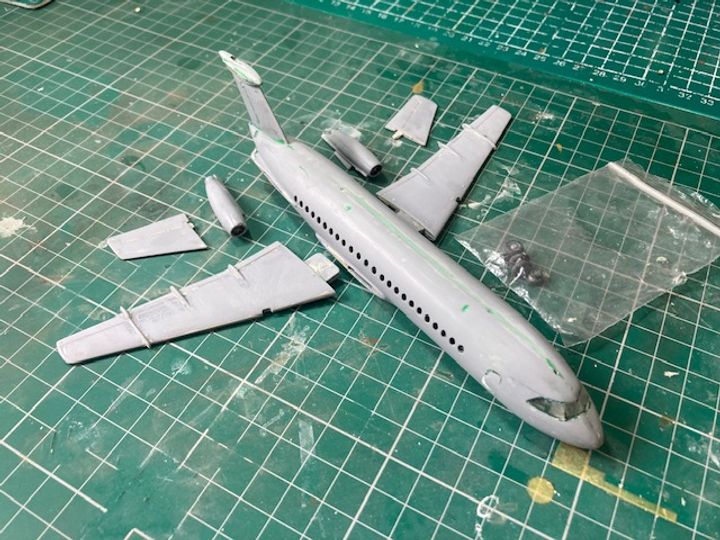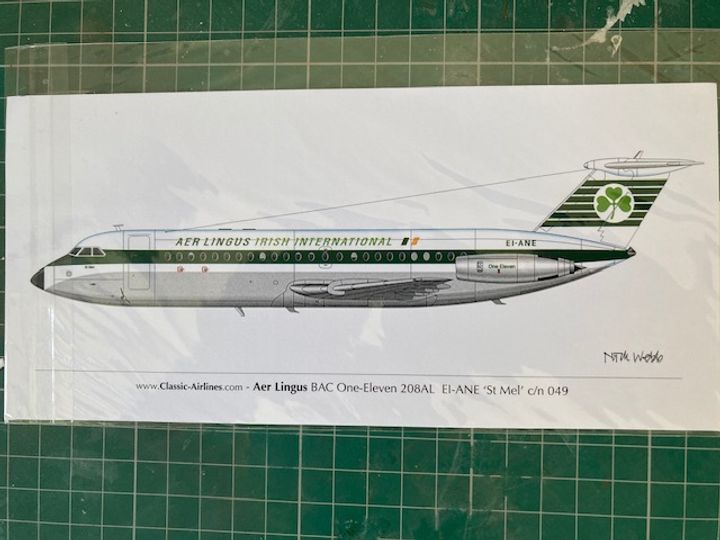Airfix BAC 1-11 200 1/144
Discussion
Another airliner restoration project I've started on is this model of the BAC 1-11.
I built this actual model around 1984/85 and, like the DC-8, it had languished on a shelf in my garage gathering dust and getting very grimy.
As you can see in the first picture, I originally attempted to to depict the model in the colours they flew in between about 1976 until they were retired in 1991. It was a bit of a bodge because back in the mid 1980s there were no dedicated decals available for that Aer Lingus scheme for BAC 1-11s so I adopted a Microscale sheet for the Boeing 737-200. This meant that the lettering and shamrock logo were oversized for the 1-11.

I have now stripped the model back and partially dismantled it.

The kit itself was originally issued by Airfix way back in 1964 and was based on the appearance of the prototype and the initial production versions. Sadly, the prototype crashed - killing famous test pilot Mike Lithgow and his crew and the early aircraft were all retrospectively upgraded. Consequently, the Airfix kit was never completely accurate for the 1-11s that actually entered service.
The key differences between the early BAC 1-11 and the operational ones are -
the nose cone of the production aircraft was more pointed as they were fitted with a weather radar
the wing fences were moved on production models
it looks like Airfix's location for the landing lights is incorrect
Airfix did not provide the exhaust for the APU which as located on the tail cone at the rear.
This time I plan to finish the model in the earlier Aer Lingus delivery scheme which the 1-11s carried from 1965 to around 1975.

Just to show how different the very early 1-11s looked, here's a shot of the ill-fated prototype -

I built this actual model around 1984/85 and, like the DC-8, it had languished on a shelf in my garage gathering dust and getting very grimy.
As you can see in the first picture, I originally attempted to to depict the model in the colours they flew in between about 1976 until they were retired in 1991. It was a bit of a bodge because back in the mid 1980s there were no dedicated decals available for that Aer Lingus scheme for BAC 1-11s so I adopted a Microscale sheet for the Boeing 737-200. This meant that the lettering and shamrock logo were oversized for the 1-11.
I have now stripped the model back and partially dismantled it.
The kit itself was originally issued by Airfix way back in 1964 and was based on the appearance of the prototype and the initial production versions. Sadly, the prototype crashed - killing famous test pilot Mike Lithgow and his crew and the early aircraft were all retrospectively upgraded. Consequently, the Airfix kit was never completely accurate for the 1-11s that actually entered service.
The key differences between the early BAC 1-11 and the operational ones are -
the nose cone of the production aircraft was more pointed as they were fitted with a weather radar
the wing fences were moved on production models
it looks like Airfix's location for the landing lights is incorrect
Airfix did not provide the exhaust for the APU which as located on the tail cone at the rear.
This time I plan to finish the model in the earlier Aer Lingus delivery scheme which the 1-11s carried from 1965 to around 1975.
Just to show how different the very early 1-11s looked, here's a shot of the ill-fated prototype -

Yes - it was an early case of a deep stall incident exacerbated by the high T-Tail layout. It was because of that accident (and a few others) that stick shakers and stick pushers were eventually mandated for airliners with this layout. Sadly, these measures still didn't prevent the crash of Trident G-ARPI at Staines in 1972.
Eric Mc said:
Yes - it was an early case of a deep stall incident exacerbated by the high T-Tail layout. It was because of that accident (and a few others) that stick shakers and stick pushers were eventually mandated for airliners with this layout. Sadly, these measures still didn't prevent the crash of Trident G-ARPI at Staines in 1972.
Although it's a pity Boeing didn't use stick shakers to warn 737 Max pilots of excessive angle of attack rather than simply push the nose down.Times move on and different solutions are used - not always successfully I have to say.
The strange thing is that, in the case of the 737 Max accidents, the crew tried to do the right thing and the plane wouldn't let them.
In the case of G-ARPI, the PLANE tried to do the right thing and the CREW wouldn't let it.
The strange thing is that, in the case of the 737 Max accidents, the crew tried to do the right thing and the plane wouldn't let them.
In the case of G-ARPI, the PLANE tried to do the right thing and the CREW wouldn't let it.
During my apprenticeship at BAC during the late 1960s I spent 2 weeks working on 1-11 rear fusalages. The planes then being built were for AA & had polished skin protected by transparent mylar film - a slip with a rivet gun meant spending unpaid time polishing out the scratch.
Part of the time I spent on Inspection. I 'snagged' a few rivets that the Chief Inspector then told me to pass. I refused to pass them so he did. The other inspectors bought my drinks after work for standing up to him.
Part of the time I spent on Inspection. I 'snagged' a few rivets that the Chief Inspector then told me to pass. I refused to pass them so he did. The other inspectors bought my drinks after work for standing up to him.
Glosphil said:
During my apprenticeship at BAC during the late 1960s I spent 2 weeks working on 1-11 rear fusalages. The planes then being built were for AA & had polished skin protected by transparent mylar film - a slip with a rivet gun meant spending unpaid time polishing out the scratch.
Part of the time I spent on Inspection. I 'snagged' a few rivets that the Chief Inspector then told me to pass. I refused to pass them so he did. The other inspectors bought my drinks after work for standing up to him.
Was that at Hurn?Part of the time I spent on Inspection. I 'snagged' a few rivets that the Chief Inspector then told me to pass. I refused to pass them so he did. The other inspectors bought my drinks after work for standing up to him.
My late father worked for BAC (later Airbus) at Filton from the late 1950s until the end of the 80s. I remember him visiting Hurn quite often when I was young, and I can’t remember whether it related to 1-11 production, but I remember him saying that they suffered with misalignment of the production jigs at Hurn due to measurable ground heave caused by the tide in the nearby Solent going in and out.
I mentioned my late uncle who worked as an engineering instructor at Aer Lingus. He also paid regular visits to Hurn - all BAC 1-11 related trips.
He was also involved with Aer Lingus' early approaches to Airbus prior to the airlines decision to acquire A320s. Sadly, he died whilst on one of these business trips to Hamburg. Gone way too early.
He was also involved with Aer Lingus' early approaches to Airbus prior to the airlines decision to acquire A320s. Sadly, he died whilst on one of these business trips to Hamburg. Gone way too early.
Yertis said:
Glosphil said:
During my apprenticeship at BAC during the late 1960s I spent 2 weeks working on 1-11 rear fusalages. The planes then being built were for AA & had polished skin protected by transparent mylar film - a slip with a rivet gun meant spending unpaid time polishing out the scratch.
Part of the time I spent on Inspection. I 'snagged' a few rivets that the Chief Inspector then told me to pass. I refused to pass them so he did. The other inspectors bought my drinks after work for standing up to him.
Was that at Hurn?Part of the time I spent on Inspection. I 'snagged' a few rivets that the Chief Inspector then told me to pass. I refused to pass them so he did. The other inspectors bought my drinks after work for standing up to him.
Polished metal finishes were popular up until the arrival of the jets in the late 1950s. Think of all those all metal Constellations, DC-4s, 6s etc.
With the arrival of the jets, the most sommon arrangement was a white upper fuselage with a polished metal underside and wings. By the mid 1960s the polished metal undersides began to be painted light grey. Wings also started getting better paint protection as well.
Polished metal is just harder and more expensive to keep clean and looking good - which is the main reason it fell out of favour.
Of course, many modern airliners have extensive use of composites in their construction so their natural colour before painting is often more like green, black or brown - so they really need to be painted.
With the arrival of the jets, the most sommon arrangement was a white upper fuselage with a polished metal underside and wings. By the mid 1960s the polished metal undersides began to be painted light grey. Wings also started getting better paint protection as well.
Polished metal is just harder and more expensive to keep clean and looking good - which is the main reason it fell out of favour.
Of course, many modern airliners have extensive use of composites in their construction so their natural colour before painting is often more like green, black or brown - so they really need to be painted.
Mark V GTD said:
Interesting use of clear Mylar. How successful was that method? My clients operate some polished metal aircraft and protection of the finish is often discussed.
The mylar was applied to the aluminium outer skins for protection during manufacture & removed when the aircraft was complete. Eric Mc said:
Polished metal finishes were popular up until the arrival of the jets in the late 1950s. Think of all those all metal Constellations, DC-4s, 6s etc.
With the arrival of the jets, the most sommon arrangement was a white upper fuselage with a polished metal underside and wings. By the mid 1960s the polished metal undersides began to be painted light grey. Wings also started getting better paint protection as well.
Polished metal is just harder and more expensive to keep clean and looking good - which is the main reason it fell out of favour.
Of course, many modern airliners have extensive use of composites in their construction so their natural colour before painting is often more like green, black or brown - so they really need to be painted.
I used to work on Tristars in the 90's and the American Trans Air Tristars were polished as part of the input.With the arrival of the jets, the most sommon arrangement was a white upper fuselage with a polished metal underside and wings. By the mid 1960s the polished metal undersides began to be painted light grey. Wings also started getting better paint protection as well.
Polished metal is just harder and more expensive to keep clean and looking good - which is the main reason it fell out of favour.
Of course, many modern airliners have extensive use of composites in their construction so their natural colour before painting is often more like green, black or brown - so they really need to be painted.
We were doing full flap and slat overhauls and a 'D' check. Some of the flaps were massive! We would polish the skins with special metal polish on a big air powered mop and the final touch was to use a sheepskin mop and plain flour from weigh and save, this pulled the polish out of the metal and gave a more chrome like bright finish.
Engine cowls and lower fuselages were polished as well.
As a side note, one of their pilots told us a freshly polished Tristar would use 3 ton less fuel crossing the Atlantic than a scruffy older one and seemed generally smother to fly.
eccles said:
I used to work on Tristars in the 90's and the American Trans Air Tristars were polished as part of the input.
We were doing full flap and slat overhauls and a 'D' check. Some of the flaps were massive! We would polish the skins with special metal polish on a big air powered mop and the final touch was to use a sheepskin mop and plain flour from weigh and save, this pulled the polish out of the metal and gave a more chrome like bright finish.
Engine cowls and lower fuselages were polished as well.
As a side note, one of their pilots told us a freshly polished Tristar would use 3 ton less fuel crossing the Atlantic than a scruffy older one and seemed generally smother to fly.
There were a number of experimental colour schemes tried in the 70s and 80s to test the pros and cons of non-painted/reduced painted fuselages. On the whole, the decision came down on the side of painting.We were doing full flap and slat overhauls and a 'D' check. Some of the flaps were massive! We would polish the skins with special metal polish on a big air powered mop and the final touch was to use a sheepskin mop and plain flour from weigh and save, this pulled the polish out of the metal and gave a more chrome like bright finish.
Engine cowls and lower fuselages were polished as well.
As a side note, one of their pilots told us a freshly polished Tristar would use 3 ton less fuel crossing the Atlantic than a scruffy older one and seemed generally smother to fly.
I know BA and Eastern had a go -


Gassing Station | Scale Models | Top of Page | What's New | My Stuff



